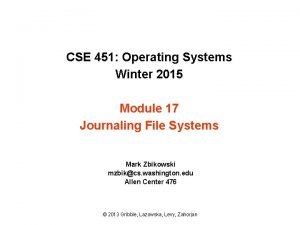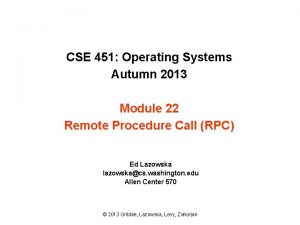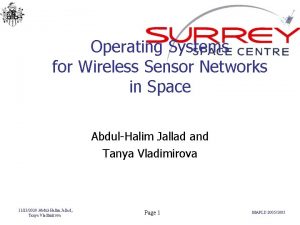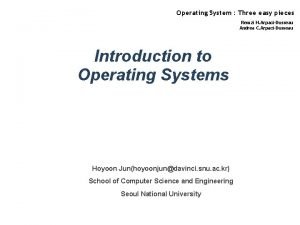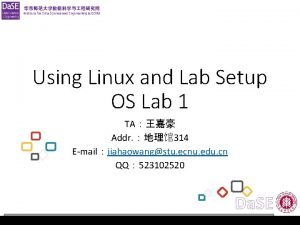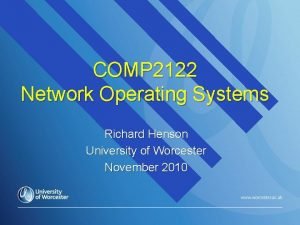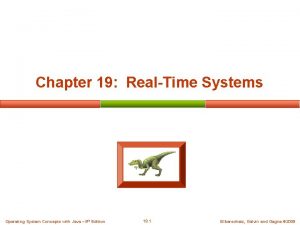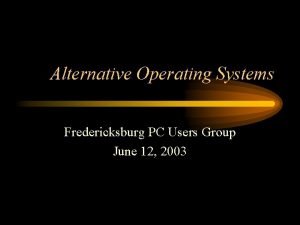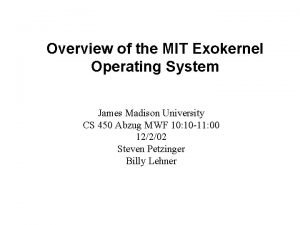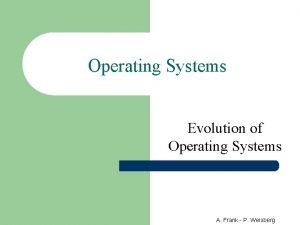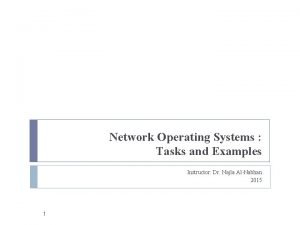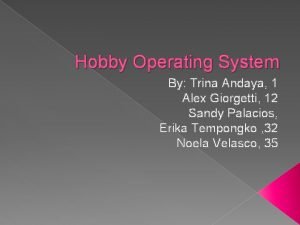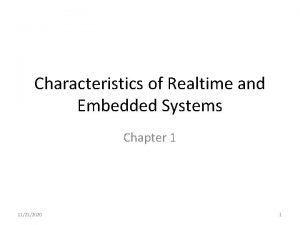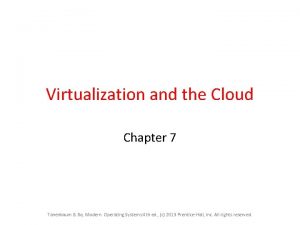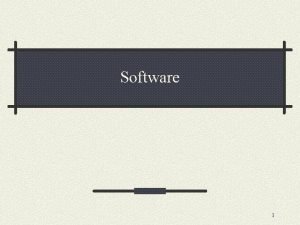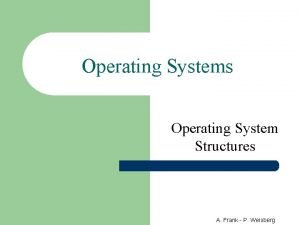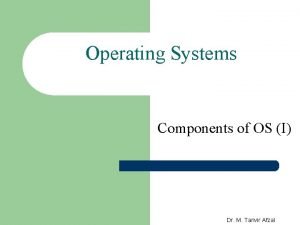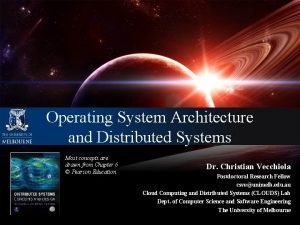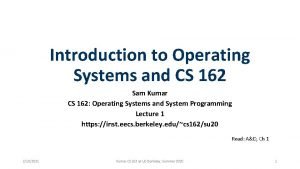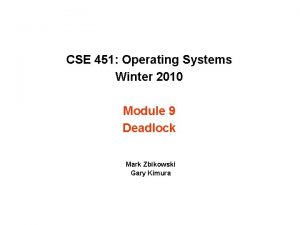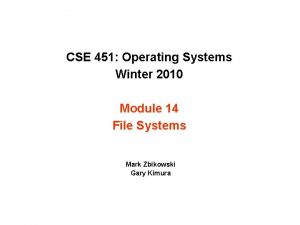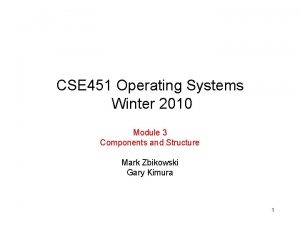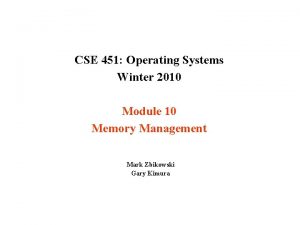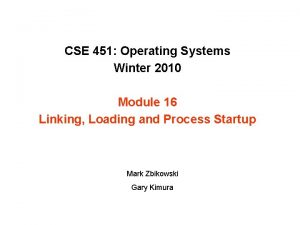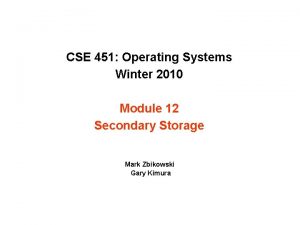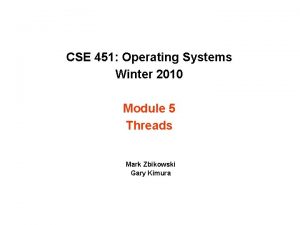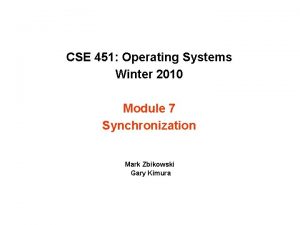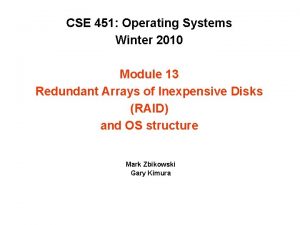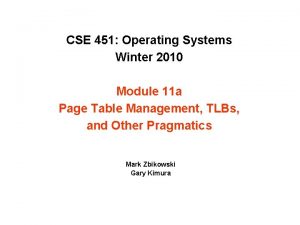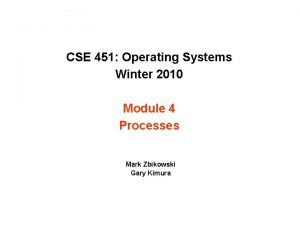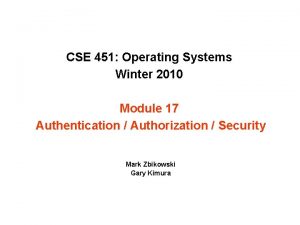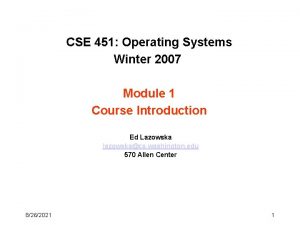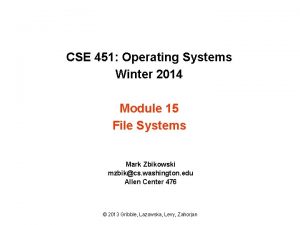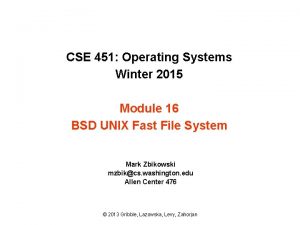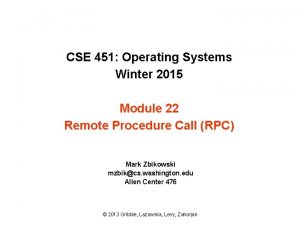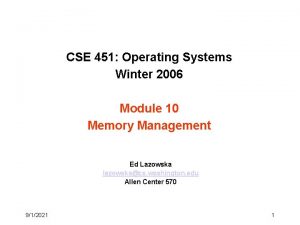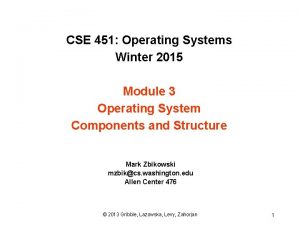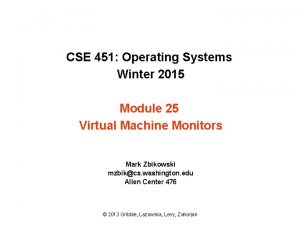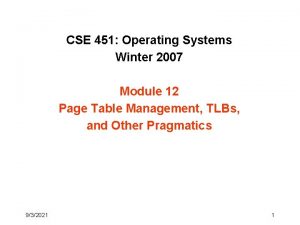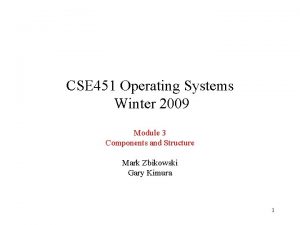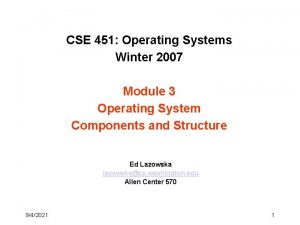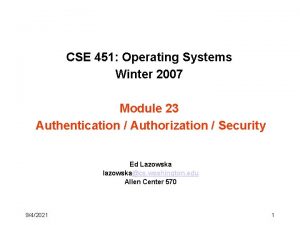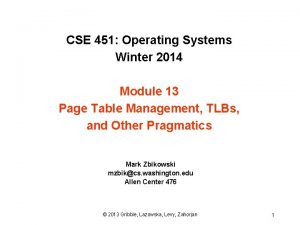CSE 451 Operating Systems Winter 2010 Module 10






































- Slides: 38

CSE 451: Operating Systems Winter 2010 Module 10 Memory Management Chia-Chi Teng ccteng@byu. edu CTB 265

Goals of memory management • Allocate scarce memory resources among competing processes, maximizing memory utilization and system throughput • Provide a convenient abstraction for programming (and for compilers, etc. ) • Provide isolation between processes – we have come to view “addressability” and “protection” as inextricably linked, even though they’re really orthogonal 6/18/2021 2

Tools of memory management • • • Base and limit registers Swapping Paging (and page tables and TLBs) Segmentation (and segment tables) Page fault handling => Virtual memory The policies that govern the use of these mechanisms 6/18/2021 3

Today’s desktop and server systems • The basic abstraction that the OS provides for memory management is virtual memory (VM) – VM enables programs to execute without requiring their entire address space to be resident in physical memory • program can also execute on machines with less RAM than it “needs” – many programs don’t need all of their code or data at once (or ever) • e. g. , branches they never take, or data they never read/write • no need to allocate memory for it, OS should adjust amount allocated based on run-time behavior – virtual memory isolates processes from each other • one process cannot name addresses visible to others; each process has its own isolated address space 6/18/2021 4

• Virtual memory requires hardware and OS support – MMU’s, TLB’s, page tables, page fault handling, … • Typically accompanied by swapping, and at least limited segmentation 6/18/2021 5

A trip down Memory Lane … • Why? – Because it’s instructive – Because embedded processors (98% or more of all processors) typically don’t have virtual memory • First, there was job-at-a-time batch programming – programs used physical addresses directly – OS loads job (perhaps using a relocating loader to “offset” branch addresses), runs it, unloads it – what if the program wouldn’t fit into memory? • manual overlays! • An embedded system may have only one program! 6/18/2021 6

• Swapping – save a program’s entire state (including its memory image) to disk – allows another program to be loaded into memory and run – saved program can be swapped back in and re-started right where it was • The first timesharing system, MIT’s “Compatible Time Sharing System” (CTSS), was a uni-programmed swapping system – only one memory-resident user – upon request completion or quantum expiration, a swap took place 6/18/2021 7

• Then came multiprogramming – multiple processes/jobs in memory at once • to overlap I/O and computation • increase CPU utilization – memory management requirements: • protection: restrict which addresses processes can use, so they can’t stomp on each other • fast translation: memory lookups must be fast, in spite of the protection scheme • fast context switching: when switching between jobs, updating memory hardware (protection and translation) must be quick 6/18/2021 8

Virtual addresses for multiprogramming • To make it easier to manage memory of multiple processes, make processes use virtual addresses (which is not what we mean by “virtual memory” today!) – virtual addresses are independent of location in physical memory (RAM) where referenced data lives • OS determines location in physical memory – instructions issued by CPU reference virtual addresses • e. g. , pointers, arguments to load/store instructions, PC … – virtual addresses are translated by hardware into physical addresses (with some setup from OS) 6/18/2021 9

• The set of virtual addresses a process can reference is its address space – many different possible mechanisms for translating virtual addresses to physical addresses • we’ll take a historical walk through them, ending up with our current techniques • Note: We are not yet talking about paging, or virtual memory – only that the program issues addresses in a virtual address space, and these must be “adjusted” to reference memory (the physical address space) – for now, think of the program as having a contiguous virtual address space that starts at 0, and a contiguous physical address space that starts somewhere else 6/18/2021 10

Old technique #1: Fixed partitions • Physical memory is broken up into fixed partitions – partitions may have different sizes, but partitioning never changes physical memory – hardware requirement: base register, limit register 0 • physical address = virtual address + base register • base register loaded by OS when it switches to a process partition 0 2 K – how do we provide protection? • if (physical address > base + limit) then… ? partition 1 • Advantages – Simple 6 K partition 2 • Problems – internal fragmentation: the available partition is larger than what was requested – external fragmentation: two small partitions left, but one big job – what sizes should the partitions be? ? 6/18/2021 8 K partition 3 12 K 11

Mechanics of fixed partitions physical memory 0 limit register base register 2 K P 2’s base: 6 K partition 0 2 K partition 1 offset virtual address <? yes + partition 2 8 K no raise protection fault 6/18/2021 6 K partition 3 12 K 12

Old technique #2: Variable partitions • Obvious next step: physical memory is broken up into partitions dynamically – partitions are tailored to programs – hardware requirements: base register, limit register – physical address = virtual address + base register – how do we provide protection? • if (physical address > base + limit) then… ? • Advantages – no internal fragmentation • simply allocate partition size to be just big enough for process (assuming we know what that is!) • Problems – external fragmentation • as we load and unload jobs, holes are left scattered throughout physical memory • slightly different than the external fragmentation for fixed partition systems 6/18/2021 13

Mechanics of variable partitions physical memory limit register base register P 3’s size P 3’s base partition 0 partition 1 partition 2 offset virtual address <? yes partition 3 no raise protection fault 6/18/2021 + partition 4 14

Dealing with fragmentation • • • Swap a program out Re-load it, adjacent to another Adjust its base register partition 0 “Lather, rinse, repeat” partition 1 Ugh partition 2 “Compaction” partition 3 partition 0 partition 1 partition 2 partition 3 partition 4 6/18/2021 15

Placement algorithm • Variable and dynamic partitions – First fit – Best fit – Next fit • Buddy system • Read the textbook 6/18/2021 16

Modern technique: Paging • Solve the external fragmentation problem by using fixed sized units in both physical and virtual memory page 0 page 1 page 2 … page 3 physical address space frame 0 frame 1 frame 2 … virtual address space frame Y page X 6/18/2021 17

User’s perspective • Processes view memory as a contiguous address space from bytes 0 through N – virtual address space (VAS) • In reality, virtual pages are scattered across physical memory frames – not contiguous as earlier – virtual-to-physical mapping – this mapping is invisible to the program • Protection is provided because a program cannot reference memory outside of its VAS – the virtual address 0 x. DEADBEEF maps to different physical addresses for different processes • Note: Assume for now that all pages of the address space are resident in memory – no “page faults” 6/18/2021 18

Address translation • Translating virtual addresses – – a virtual address has two parts: virtual page number & offset virtual page number (VPN) is index into a page table entry contains page frame number (PFN) physical address is PFN: : offset • Page tables – managed by the OS – map virtual page number (VPN) to page frame number (PFN) • VPN is simply an index into the page table – one page table entry (PTE) per page in virtual address space • i. e. , one PTE per VPN 6/18/2021 19

Mechanics of address translation virtual address virtual page # offset physical memory page table physical address page frame # offset … page frame # page frame 0 page frame 1 page frame 2 page frame 3 page frame Y 6/18/2021 20

Example of address translation • Assume 32 bit addresses – assume page size is 4 KB (4096 bytes, or 212 bytes) – VPN is 20 bits long (220 VPNs), offset is 12 bits long Let’s translate virtual address 9000 decimal – VPN is 2, and offset is 808 decimal – assume page table entry 2 contains value 4 • page frame number is 4 • VPN 2 maps to PFN 4 – physical address = PF base + offset = 4*4096 + 808 = 16384 + 808 = 17192 4 G-1 virtual page 220 -1 virtual address 9000 = 2* 4096 + 808 2 808 page table 4 4 808 physical address = 4 * 4096 + 808 = 17192 physical memory page frame 0 page frame 1 page frame 2 page frame 3 page frame 4 … Virtual address space virtual page 0 4096 virtual page 1 8192 virtual page 3 virtual page 4 0 … • page frame Y

Example of address translation • How about in binary? • Still assume 32 bit addresses – assume page size is 4 KB (4096 bytes, or 212 bytes) – VPN is 20 bits long (220 VPNs), offset is 12 bits long • Let’s translate virtual address 0 x 13325328 – VPN is 0 x 13325, and offset is 0 x 328 – assume page table entry 0 x 13325 contains value 0 x 03004 • page frame number is 0 x 03004 • VPN 0 x 13325 maps to PFN 0 x 03004 – physical address = PFN: : offset = 0 x 03004328 6/18/2021 22

Exercise • Considering a simple paging system with 220 bytes of physical memory, 228 bytes of virtual address space, and page size of 1 K bytes. – How many entries in the page table? 228/1 K = 218 , or 256 M/1 K = 256 K – How many bits in the virtual address used to specify the page #? 28 – 10 = 18 – How many bits in the physical address used to specify the frame #? 20 – 10 = 10

Exercise • Considering the following page table. – Assume the page size is 2048 bytes, all numbers are decimal and zero based. What is the physical address for the virtual address 2096? Virtual page # 0 1 2 3 Valid 1 1 1 0 Physical Frame # 10 4 2 - VPN = 1 Offset = 2096 – 2048 = 48 PF = 4 Physical address = 4 * 2048 + 48 = 8240 6/18/2021 24

Page Table Entries (PTEs) 1 1 1 2 V R M prot 20 page frame number • PTE’s control mapping – the valid bit says whether or not the PTE can be used • says whether or not a virtual address is valid • it is checked each time a virtual address is used – the referenced bit says whether the page has been accessed • it is set when a page has been read or written to – the modified bit says whether or not the page is dirty • it is set when a write to the page has occurred – the protection bits control which operations are allowed • read, write, execute – the page frame number determines the physical page • physical page start address = PFN 6/18/2021 25

Paging advantages • Easy to allocate physical memory – physical memory is allocated from free list of frames • to allocate a frame, just remove it from the free list – external fragmentation is not a problem! • managing variable-sized allocations is a huge pain in the neck – “buddy system” • Leads naturally to virtual memory – entire program need not be memory resident – take page faults using “valid” bit – but paging was originally introduced to deal with external fragmentation, not to allow programs to be partially resident 6/18/2021 26

Paging disadvantages • Can still have internal fragmentation – process may not use memory in exact multiples of pages • Memory reference overhead – 2 references per address lookup (page table, then memory) – solution: use a hardware cache to absorb page table lookups • translation lookaside buffer (TLB) – next class • Memory required to hold page tables can be large – need one PTE per page in virtual address space – 32 bit AS with 4 KB pages = 220 PTEs = 1, 048, 576 PTEs – 4 bytes/PTE = 4 MB per page table • OS’s typically have separate page tables per process • 25 processes = 100 MB of page tables – solution: page the page tables (!!!) • (ow, my brain hurts) 6/18/2021 27

Multi-level page table • x 86 4 KB page architecture 6/18/2021 28

4 MB page size extension 6/18/2021 29

Segmentation (We will be back to paging soon!) • Paging – mitigates various memory allocation complexities (e. g. , fragmentation) – view an address space as a linear array of bytes – divide it into pages of equal size (e. g. , 4 KB) – use a page table to map virtual pages to physical page frames • page (logical) => page frame (physical) • Segmentation – partition an address space into logical units • stack, code, data, heap, subroutines, … – a virtual address is <segment #, offset> 6/18/2021 30

What’s the point? • More “logical” – absent segmentation, a linker takes a bunch of independent modules that call each other and linearizes them – they are really independent; segmentation treats them as such • Facilitates sharing and reuse – a segment is a natural unit of sharing – a subroutine or function • A natural extension of variable-sized partitions – variable-sized partition = 1 segment/process – segmentation = many segments/process 6/18/2021 31

Hardware support • Segment table – multiple base/limit pairs, one per segment – segments named by segment #, used as index into table • a virtual address is <segment #, offset> – offset of virtual address added to base address of segment to yield physical address 6/18/2021 32

Segment lookups segment table limit physical memory base segment 0 segment # offset segment 1 virtual address segment 2 <? yes + segment 3 no raise protection fault 6/18/2021 segment 4 33

Pros and cons • Yes, it’s “logical” and it facilitates sharing and reuse • But it has all the horror of a variable partition system – except that linking is simpler, and the “chunks” that must be allocated are smaller than a “typical” linear address space • What to do? 6/18/2021 34

Combining segmentation and paging • Can combine these techniques – x 86 architecture supports both segments and paging • Use segments to manage logical units – segments vary in size, but are typically large (multiple pages) • Use pages to partition segments into fixed-size chunks – each segment has its own page table • there is a page table per segment, rather than per user address space – memory allocation becomes easy once again • no contiguous allocation, no external fragmentation Segment # Page # Offset within page Offset within segment 6/18/2021 35

Combining segmentation and paging Offset within segment virtual address Segment # Page # Offset within Page physical memory page frame 0 segment table physical address Limit page frame # Page Table page table offset page frame 1 page frame 2 page frame # … page frame 3 page frame Y 6/18/2021 36

• Linux: – – – 1 kernel code segment, 1 kernel data segment 1 user code segment, 1 user data segment N task state segments (stores registers on context switch) 1 “local descriptor table” segment (not really used) all of these segments are paged • Note: this is a very limited/boring use of segments! • WHY? 6/18/2021 37

Administrivia • Midterm – Blackboard online test, open book – Available on BB Thursday Feb 25, approx 10 AM, due 11: 59 PM Monday Mar 1 – Covering Chapters 1 -7 & 9 • Quiz 3 • Project 2 – – – Email me your project ideas NOW Part 1: proposal, due this Friday Part 2: start compiling Part 3: finish building Part 4: run, demo, write-up 6/18/2021 38
 Module 4 operating systems and file management
Module 4 operating systems and file management Winter kommt winter kommt flocken fallen nieder
Winter kommt winter kommt flocken fallen nieder Winter kommt flocken fallen nieder
Winter kommt flocken fallen nieder Meine lieblingsjahreszeit ist der winter
Meine lieblingsjahreszeit ist der winter Cse 451
Cse 451 Cse 451
Cse 451 Embedded innovator winter 2010
Embedded innovator winter 2010 C device module module 1
C device module module 1 Definition of operating system
Definition of operating system Evolution of operating systems
Evolution of operating systems Components of an operating system
Components of an operating system Component of operating systems
Component of operating systems Wsn operating systems
Wsn operating systems Operating systems tree
Operating systems tree Operating systems lab
Operating systems lab What is dual mode in os
What is dual mode in os Modern operating systems
Modern operating systems What are the main components of file management
What are the main components of file management Design issues of distributed operating system
Design issues of distributed operating system Early operating systems
Early operating systems Real-time operating systems
Real-time operating systems Can we make operating systems reliable and secure
Can we make operating systems reliable and secure Alternative operating systems
Alternative operating systems Exokernel
Exokernel Operating system internals and design principles
Operating system internals and design principles Evolution of operating systems
Evolution of operating systems Network operating system example
Network operating system example Visual studio 2005 team suite
Visual studio 2005 team suite Hobby operating systems
Hobby operating systems Characteristics of real time operating system
Characteristics of real time operating system Operating systems concepts
Operating systems concepts Operating system history
Operating system history Virtualization technology in modern operating systems
Virtualization technology in modern operating systems Application software is divided into
Application software is divided into Slidetodoc.com
Slidetodoc.com Components of operating systems
Components of operating systems Os architecture
Os architecture Modern operating systems 3rd edition
Modern operating systems 3rd edition Uc berkeley operating systems
Uc berkeley operating systems




